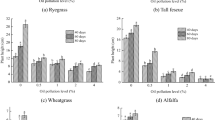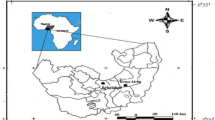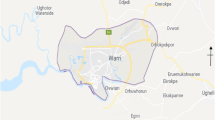Abstract
Percentage germination, plant height, leaf area, relative dry matter yield, plant nutrient concentration, soil chemical characteristics and source/sink relationship were assessed for maize (Zea mays L TZ-SR-Y) planted in a soil polluted with 3% (v/w) crude oil or 0% (untreated soil), after remediation of soil with different organic (Poultry manure, peptone water, sawdust and yeast extract) and inorganic (NPK, KNO3, NH4H2PO4 and (NH4)2SO4) nutrient supplements applied 7 days after oil treatment. Germination of maize in oil polluted soil was not significantly affected by nutrient supplementation (P=0.05). Maize performance in terms of other studied parameters was highest in the oil polluted soil supplemented with poultry manure, and least in oil polluted soil supplemented with sawdust. Oil treatment correlated significantly with organic C, N, Na, Mg and ferrous in the soil (P=0.05) and with nutrient composition in maize plant tissues (P=0.05). For nutrient uptake, significant correlation was only established between soil N and plant N. Population of petroleum hydrocarbon tolerant microbes increased initially but decreased with time. There is every indication that nutrient supplementation of oil polluted soil especially with organic nutrient sources is beneficial for maize growth, because the C/N ratio is narrowed while the rate of biodegradation of oil and soil recovery is also enhanced. Poultry manure is recommended, however sawdust is not recommended since it tends to impose adverse effect by widening the C/N ratio in soil.
Similar content being viewed by others
References
Atlas, R. M., Schofield, E. A., Morelli, F. A., and Cameron, R. E.: 1976, Environ. Pollut. 10, 35.
Atlas, R. M. and Bartha, R.: 1973, Environ. Sci. Technol. 7, 538.
Baker, J. M.: 1970, Environ. Pollut. 1, 27.
Bossert, I. and Bartha, R.: 1984, in Atlas, R. M. (ed.), Petroleum Microbiology, Macmillan Pub. Co., New York, pp. 435–473.
Bray, R. T. H. and Kurtz, L. T.: 1945, Soil Science 59, 39.
Bremner, J. M.: 1965, in Black C. A. (ed.), Methods of Soil Analysis, Part II, Amer. Soc. Agron. Madison Wisconson 9, 1149.
Cook, F. D., and Wesklake, D. W. S.: 1973, ‘Biodegradability of Northern Crude Oils’, ALUR 75-76-81. Indian and Northern Affairs Publ. No. QS 8116-000-EE-AL. University of Alberta, Canada.
Delaune, R. D., Patrick, W. H., and Buresh, J. R.: 1979, Environ. Pollut. 13, 23.
Hunt, P. G., Richard, W. E., Deneke, T. J., Koutz, F. R., and Murnman, R. P.: 1973, Terrestrial Oil Spills in Alaska: Environmental Effects and Recovery, in Proc. Joint Contr. Prevention and Control of Oil Spills, Amer. Petrol. Inst. Wash. D.C. pp. 733–744.
Jeffrey, J. J. and Uren, N. C.: 1979, ‘The Effect of the Application of Piggery Effluent to Soils and Pastures’, Proq. Wat. Tech. 11, 275.
Labanauskas, C. K.: 1966, in Chapman, H. D. (ed.), Diagnostic criteria for Plant and Soils, Div. of Agric. Science, pp. 264–285.
Lehtomaki, M. and Niemela, S.: 1975, Ambio. 4, 126.
McGill, W. B.: 1980, in Disposal of Industrial and Oily Sludges by Land Cultivation, Pub. Resource systems mangt. Assoc. pp. 103–122.
McGill, W. B. and Nyborg, M. P.: 1975, Reclamation of Wet Forrested Soils Subjected to Oil Spills. Report on contract No. OSP 3-0073 for Northern Forest Research Center Edmonton, DIP. Pub. No. G-75-1. Univ. of Alberta, 129 pp.
Morris, H. D.: 1948, ‘The Soluble Manganese Content of Acid Soils and its Relation to the Growth and Manganese Content of Sweet Clover and Bespedeza’, Soil Science Soc. Amer. Proc. 13, 1362.
Odu, C. T. I.: 1972, J. Inst. Petrol. 58, 201.
Odu, C. T. I.: 1981, Proc. Seminar on the Petroleum Industry and the Nigerian Environement, pp. 143–153.
Odu, C. T. I.; Nwoboshi, L. C., Fagade, S. O., and Awani, P. E.: 1989, ‘The Post-Impact Study of SPDC's 16 Delivery Line Spillage at Nun River’, Final Report to SPDC, Lagos 112p. Univ. of Ibadan, Nigeria.
Plice, M. J.: 1948, Some Effects of Crude Petroleum on Fertility, Soil Sci. Soc. Amer. Proc. 13, 413.
Rowell, M. J.: 1977, in Toogood J. A.(ed.), Reclamation of Agricultural Soils after Oil Spills, Part. I. Research AIP Pub. p. 1–27.
Schwendinger, R. B.: 1968, J. Inst. Petrol. 54, 182.
Toogood, J. A., Nyborg, M., and Rowell, M. J.: 1977, in: Toogood, J. A. (ed.), Reclamation of Agricultural Soils after Oil Spills, Part 1. Research. AIP. Pub. pp. 34–38. University of Alberta, Canada.
Udo, E. J. and Fayemi, A. A.: 1975, J. Environ. Qual. 4, 537.
Walkley, A. and Black, I.: 1934, Soil Science 37, 29.
Author information
Authors and Affiliations
Rights and permissions
About this article
Cite this article
Amadi, A., Dickson, A.A. & Maate, G.O. Remediation of oil polluted soils: 1. effect of organic and inorganic nutrient supplements on the performance of maize (Zea may L). Water Air Soil Pollut 66, 59–76 (1993). https://doi.org/10.1007/BF00477060
Received:
Revised:
Issue Date:
DOI: https://doi.org/10.1007/BF00477060




